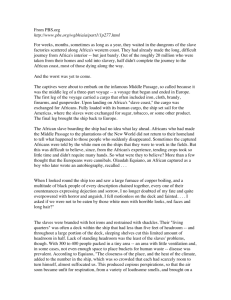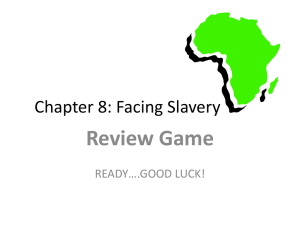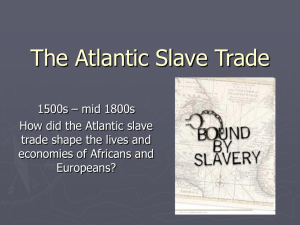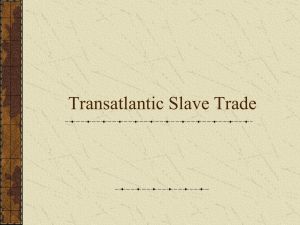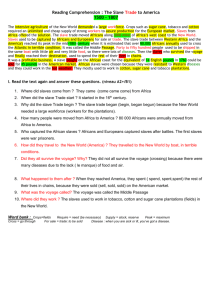The Middle Passage
advertisement
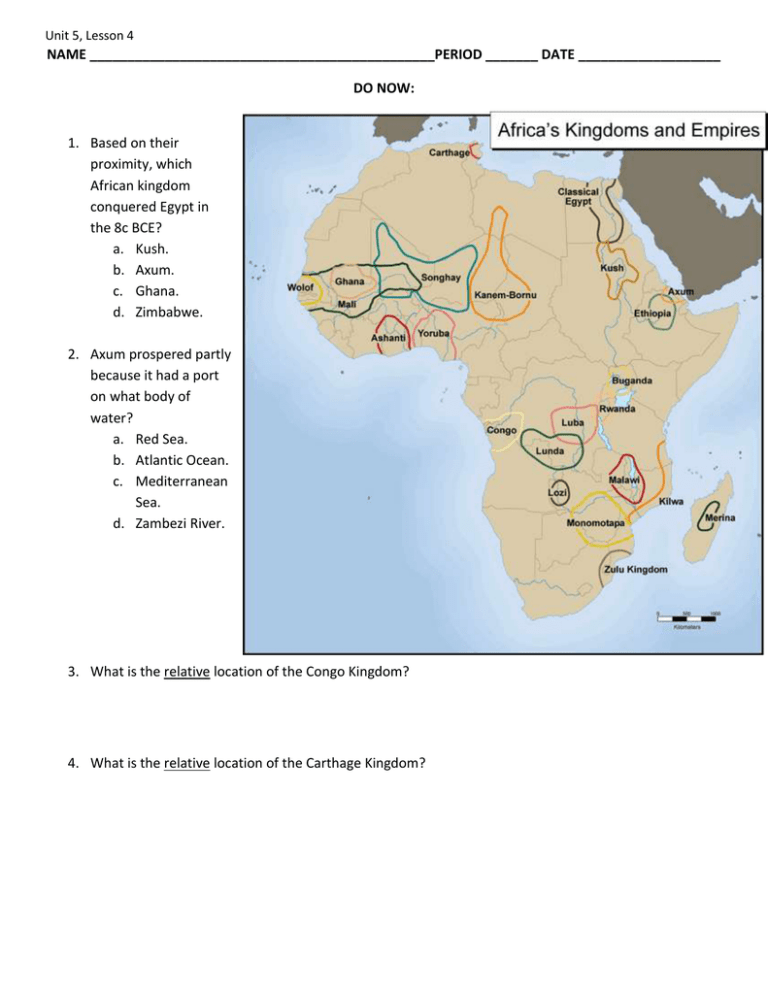
Unit 5, Lesson 4 NAME ______________________________________________PERIOD _______ DATE ___________________ DO NOW: 1. Based on their proximity, which African kingdom conquered Egypt in the 8c BCE? a. Kush. b. Axum. c. Ghana. d. Zimbabwe. 2. Axum prospered partly because it had a port on what body of water? a. Red Sea. b. Atlantic Ocean. c. Mediterranean Sea. d. Zambezi River. 3. What is the relative location of the Congo Kingdom? 4. What is the relative location of the Carthage Kingdom? Unit 5, Lesson 4 Notes The __________________ Trade is the name given to the trading of ________________ and _______________ between ____________, ___________ and the ________________. The ______________________________________ was the specific route from __________ to the Americas that the _______________ were taken on. __________________ African states would capture and _________ their enemies – the interior ___________________ states – to the _________________________________. _______________________________ is when two groups __________ each other and lean on each other to ______________________________________________. Europeans wanted ___________ and ________________, ________________ wanted _____________ and _____________________. Unit 5, Lesson 4 The Middle Passage For weeks, months, sometimes as long as a year, captured Africans waited in the dungeons of the slave factories scattered along Africa's western coast. They had already made the long, difficult journey from Africa's interior to the coast -- but just barely. Out of the roughly 20 million who were taken from their homes and sold into slavery, half didn't complete the journey to the African coast, most of those dying along the way from the abusive treatment of their captors. And the worst was yet to come. The captives were about to embark on the Middle Passage. This journey was named the Middle Passage because it was the middle part of a three-part voyage -- a voyage that began and ended in Europe. The first leg of the voyage carried a cargo that often included iron, cloth, brandy, firearms, and gunpowder. Upon landing on Africa's "slave coast," the cargo was exchanged for Africans. Fully loaded with its human cargo, the ship set sail for the Americas, where the slaves were exchanged for sugar, tobacco, or some other product. The final leg brought the ship back to Europe. The African slaves boarding the ships had no idea what lay ahead of them. No Africans who had been captured and sold to slavers had ever returned to Africa. Thus, no one ever knew what happened to slaves once they boarded the ships. So what were they to believe? More than a few thought that the Europeans were cannibals. Olaudah Equiano, an African captured as a boy who later wrote an autobiography, recalled: When I looked round the ship too and saw a large furnace of copper boiling, and a multitude of black people of every description chained together, every one of their countenances expressing dejection and sorrow, I no longer doubted of my fate and quite overpowered with horror and anguish, I fell motionless on the deck and fainted. . . . I asked if we were not to be eaten by those white men with horrible looks, red faces and long hair?" For slaves, the trip was a nightmare. They were allowed little exercise. Pairs of men were chained together at the ankle and wrist. There was too little space between ships decks to sit up or to stand. Often men, women, and children were packed so closely together that they could barely move. Many were covered with sores from lying on the rough floorboards. Unit 5, Lesson 4 With 300 to 400 people packed in a tiny areas -- an area with little ventilation and, in some cases, not even enough space to place buckets for human waste -- disease was prevalent. Sharks followed the ships, feeding on the dead who were thrown overboard. According to Equiano, The closeness of the place, and the heat of the climate, added to the number in the ship, which was so crowded that each had scarcely room to turn himself, almost suffocated us. This produced copious perspirations, so that the air soon became unfit for respiration, from a variety of loathsome smells, and brought on a sickness among the slaves, of which many died. Faced with the nightmarish conditions of the voyage and the unknown future that lay beyond, many Africans would rather have died than lived on that ship. But even the choice of suicide was taken away from these people. From the captain's point of view, his human cargo was extremely valuable and had to be kept alive and, if possible, uninjured. A slave who tried to starve him or herself was tortured. If torture didn't work, the slave was force fed with the help of a contraption called a speculum orum, which held the mouth open. Despite the captain's desire to keep as many slaves as possible alive, Middle Passage mortality rates were high. Although it's difficult to determine how many Africans died en route to the new world, it is now believed that between ten and twenty percent of those transported lost their lives. ¶# Methods of Control ¶# Unhealthy Conditions Unit 5, Lesson 4 Name: _____________________________ Date: _____________________________ Advisory: ______________________________ Exit Ticket 1. Which of the following is the best definition for slavery? a. Not letting people vote or have a say in their government b. People having to follow strict rules at their jobs c. when a person owns or has complete control of another person or other people d. Living in a country with unlimited government 2. What was the main reason for the Transatlantic Slave Trade/Middle Passage? ____________________________________________________________________________________ ____________________________________________________________________________________ ____________________________________________________________________________________ 3. The Middle Passage was: a. The journey of explorers through the middle of Africa b. The journey of slaves through the middle of Africa c. The journey of slaves from Africa to the Americas d. The journey of colonists to the Americas 4. Describe the living conditions of the Africans during the Middle Passage. ____________________________________________________________________________________ ____________________________________________________________________________________ ____________________________________________________________________________________ 5. Create a sketch of what the Triangular Trade looked like.
